Optional: listen text-to-speech using the voices already in your device
This feature makes use of the Text-To-Speech capability as you have it already installed and configured on your own device. You will see that there are some voices that are not so good, choose from the list if you have a chance.
The surface density of monuments per square meter in Rome is overwhelming. But not the kind of monuments that are so because they are rooms or ancient buildings that are well preserved and are representative of a way of life, or an artifact (here is a mill of the fourth century) or something like that. I mean monuments that were already monuments from the time they were built. Memorial arches, temples, theaters, forums…. True, as Rome has been a capital of the world for many centuries… there must be a lot of them. I buy it. But this city is all filled up to the top!
Walking through the Rome of the splendor of the Empire must have been heavenly. If it is almost as heavenly today…
The seven hills of Rome (in Latin, Septem Montes) are a group of hills that historically were the core of the ancient city of Rome: Palatine (Palatium), Capitoline (Campidoglio), Aventine (Aventinus), Quirinal (Quirinalis), Esquiline (Esquilin), Viminal (Viminalis) and Mount Celio (Caelius) and are intrinsically linked to the creation of Rome.

Capitoline Hill
The Campidoglio or Capitoline Hill (Collis Capitulinus) is one of the seven hills of Rome. It was the political and religious center of Rome for centuries, being the site of the ancient Civitas, or original city of Rome.
The Theater of Marcellus was built at the base of the Capitoline Hill between 23 BC and 17 BC by Emperor Caesar Augustus – although its inauguration took place under the rule of his successor, Tiberius – to give shape to the process of consolidating his power after his victory over Mark Antony and Cleopatra. It was named in honor of Augustus’ nephew, Marcus Claudius Marcellus, who died at the early age of 19. With a capacity for about 20,000 spectators, its shape was hemispherical, which allowed a perfect visibility of the scene from almost anywhere in the theater.

The Temple of Apollo Sosianus was a temple dedicated to Apollo, the Greek god of music, arts, prophecy and healing, and is known for its connection to the political party of the Sosii, an important family of Rome. The temple was built in 34 BC, during the consulship of Gaius Sosius and Lucius Cornelius Balbus. It was dedicated by Gaius Sosius (a member of the Sosii family), who was a close supporter of Caesar and later of Octavian Augustus; hence the name “Sosianus”. The dedication to Apollo was related to the vow made by Julius Caesar before the battle of Pharsalus (48 BC), in which he asked the help of the god Apollo for victory.

The Piazza del Campidoglio was designed by Michelangelo Buonarroti between 1536 and 1546. The square has a trapezoidal shape and is surrounded by three buildings: the Palazzo Senatorio, the Palazzo dei Conservatori and the Palazzo Nuovo. In the center of the square is a bronze fountain with an equestrian statue of Emperor Marcus Aurelius, made in the second century.
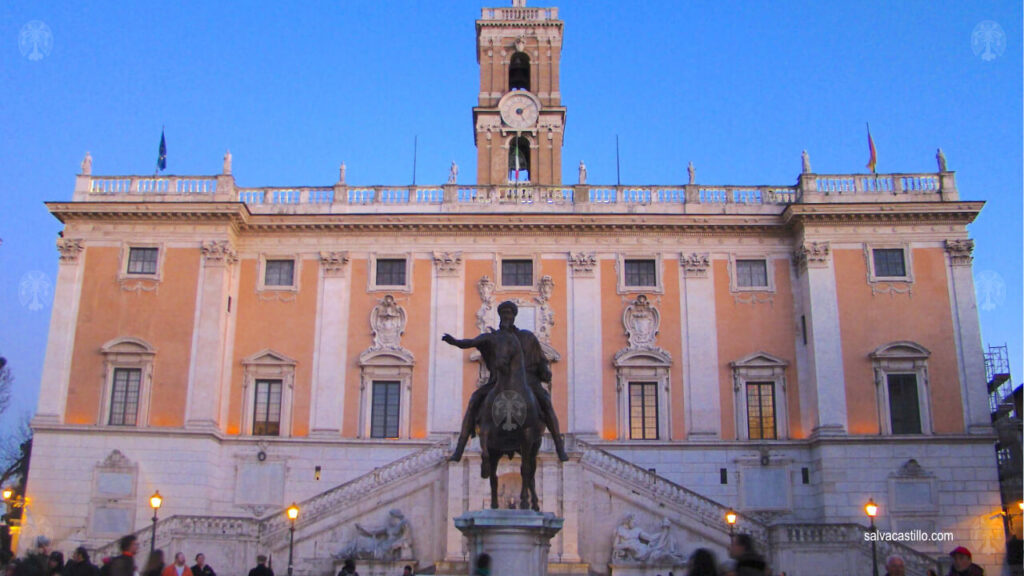
The Cola di Rienzo Monument is located next to the Campidoglio. Cola di Rienzo is an important historical figure of the 14th century for his ambition to revive the republican ideals of ancient Rome. His figure was seen in the Renaissance as a harbinger of freedom and independence for Rome, as well as a symbol of the struggle against tyranny. His name is linked to a period of political turbulence in Rome and the end of the dynasty of the Avignonese Popes who ruled the city from exile in France. Cola di Rienzo proclaimed himself Tribune of the People in 1347, a title that evoked the leaders of ancient Rome, the tribunes of the plebs, who were elected to defend the interests of the common people against the aristocracy. Rienzo, a man of humble but well-educated origins, became the leader of a popular revolt in Rome against the nobility and the growing influence of the papacy. His rule was short-lived and ended tragically with his execution in 1354.

The Lupa Capitolina or Luperca, located at an entrance to the Piazza del Campidoglio, depicts a she-wolf suckling the twins Romulus and Remus, who according to Roman mythology were abandoned on the banks of the Tiber River and then saved and nursed by this she-wolf, a symbol of the protection and birth of Rome. According to legend, the she-wolf nursed the twins in a cave called Lupercal, located at the base of Rome’s Palatine Hill.
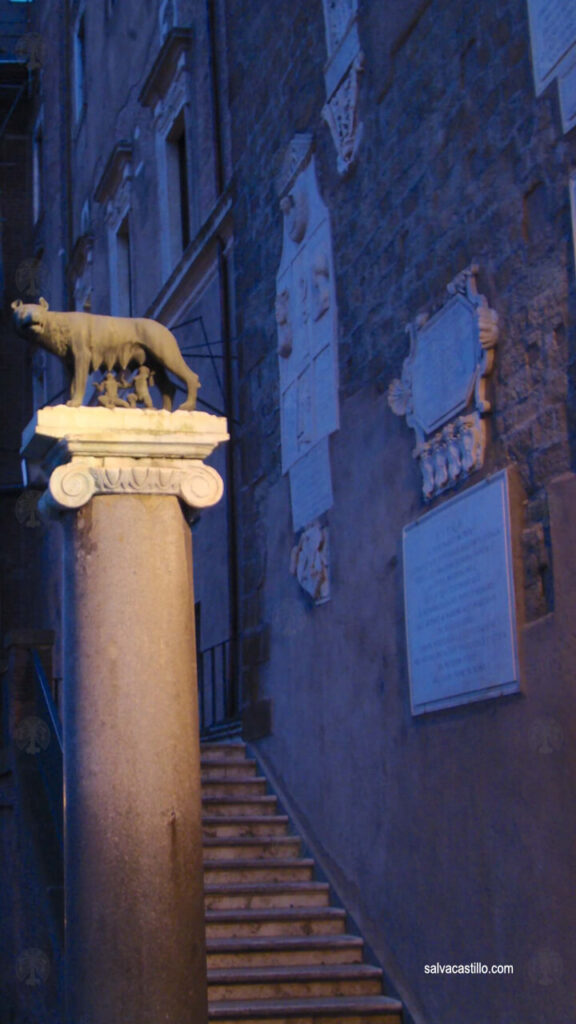
The Monument to Vittorio Emanuele II, also known as Vittoriano or Altar of the Homeland, is one of the largest and most emblematic monuments in Rome. It is located in Piazza Venezia, at the foot of the Capitoline Hill, and was erected to pay homage to Vittorio Emanuele II, the first king of Italy, and to the unification of the country.

Construction of the monument began in 1885, shortly after the death of Vittorio Emanuele II, and was completed in 1911, as part of the celebrations for the 50th anniversary of the unification of Italy.

At the center of the monument is the large equestrian statue of Vittorio Emanuele II, depicted on horseback. The statue, made of bronze, is about 12 meters high. The lower part of the monument houses the Altar of the Homeland, a symbolic place dedicated to the memory of the king and the foundation of unified Italy. In this space there is also the Tomb of the Unknown Soldier.

Roman Forum
For centuries, the Forum was the place where the main activities of the Roman Republic and, later, of the Roman Empire took place. The Roman Forum is located in a deep plain between the hills of the Palatine Hill and the Capitoline Hill, in the heart of ancient Rome.

During the Roman Republic (509 BC – 27 BC), the Forum was used for political assemblies, courts of justice and public speeches. In the Imperial period, the Roman Forum was enlarged and embellished under emperors such as Augustus, Trajan and Domitian, who built new temples, basilicas and monuments, making it the great symbol of Roman grandeur.

The Aedes Saturni (Temple of Saturn) was founded in 497 BC by the Roman dictator Aulus Postumius Albinus after a military victory. It was one of the most important temples of ancient Rome, dedicated to Saturn, the god of agriculture, crops, wealth, time and abundance.
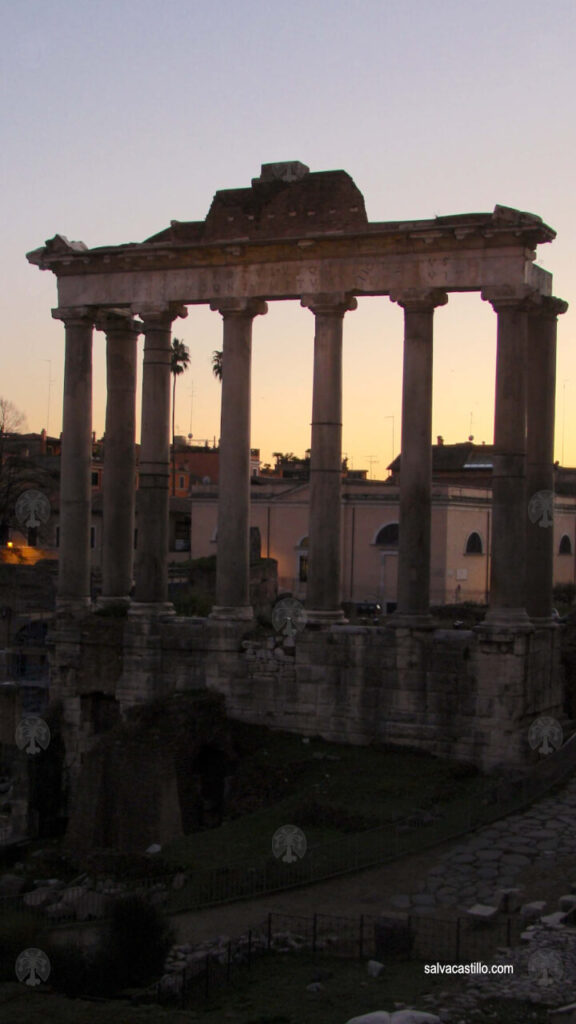
The Arch of Septimius Severus was erected to commemorate the military victory of Emperor Severus (193-211 A.D.) and his two sons, Caracalla and Geta, in the war against the Parthians (circa 195-198 A.D.).
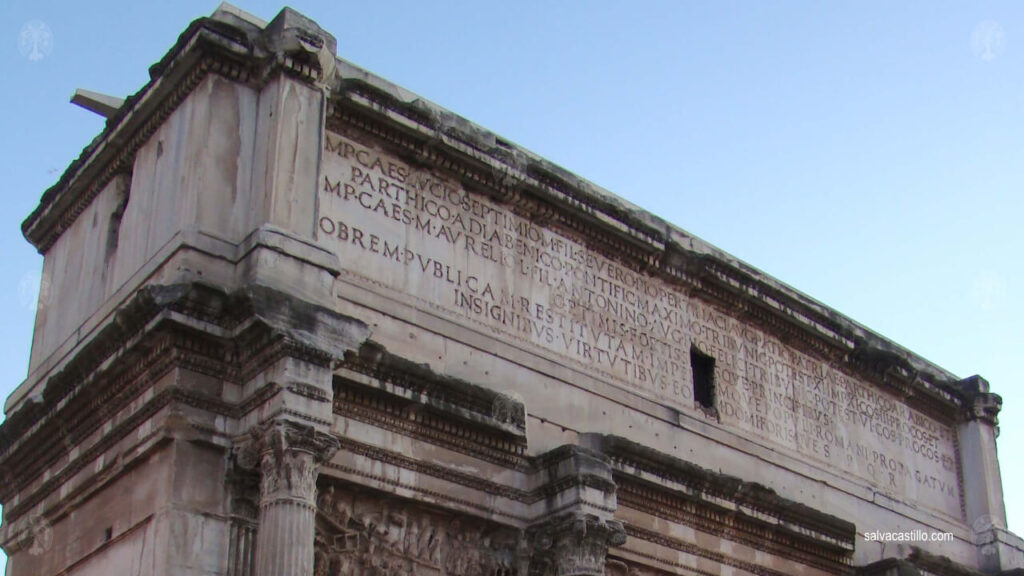
The arch marks the entry point to the Roman Forum from the Via Sacra, which was the main street that crossed Rome in the direction of the Capitol. It is 23 meters high, 25.7 meters wide and 11 meters deep.


Nerva’s Forum
The Nerva’ Forum (in Latin, Forum Nervae) was one of the imperial forums of ancient Rome, located in the center of the city, between the Roman Forum and the Forum of Augustus. It is the smallest of the imperial forums and is characterized by its late construction, which took place during the reign of Emperor Nerva (96-98 AD), although its inauguration occurred under the rule of Trajan, his successor.

Caesar’s Forum
The Temple of Venus Genetrix (in Latin, Templum Veneris Genetricis) was built by Julius Caesar in Caesar’s Forum between 54 BC and 29 BC, following a vow made during the Gallic War.

It is dedicated to Venus Genetrix, a form of the goddess Venus who was considered the mother of Julius Caesar and, therefore, a symbol of his divine lineage. According to Roman mythology, Venus had been the mother of Aeneas, and from this Trojan hero descended the Roman emperors.

Augutus’ Forum
The Augustus’ Forum (in Latin, Forum Augusti) was the second imperial forum after the Forum of Caesar, built by Augustus, the first emperor of Rome, as part of his project to beautify the city and reinforce his authority. This forum, inaugurated in 2 BC, was part of a larger program that included the reconstruction of the forums of Caesar and Nerva. Augustus built this forum to commemorate his victory at the Battle of Philippi (42 BC), where he and his ally Mark Antony defeated Julius Caesar’s assassins, Cassius and Brutus.

Palatine Hill
According to Roman mythology, the Palatine Hill (Collis Palatinum) is the place where Romulus founded Rome on April 21, 753 BC, thus becoming the starting point (“Domus Augustana”) of the expansion of the city. During the Roman Republic, the Palatine was already a residential area of the Roman aristocracy, but it was with the rise of the Roman Empire that it became the center of imperial life.
The Arch of Titus, although not located directly on the Palatine Hill, is very close to the hill. It was built in 81 AD in honor of Emperor Titus, and commemorates Titus’ victory in the Jewish War and the destruction of Jerusalem. The arch is decorated with reliefs depicting the sack of Jerusalem and the triumph of Titus, including the famous image of the trophies of Jerusalem, such as the Menorah.

Quirinal Hill
In ancient Rome, the Quirinal (Collis Quirinalis) was known as a hill associated with the gods of war and protection. Today it houses the Quirinal Palace, which is currently the official residence of the President of the Italian Republic.
The Quirinal Square is a place of great ceremonial importance, since it is where the official ceremonies of the President of the Republic are held. The Quirinal Obelisk is an Egyptian obelisk that was brought to Rome by Emperor Augustus in 10 B.C. from Heliopolis, Egypt.
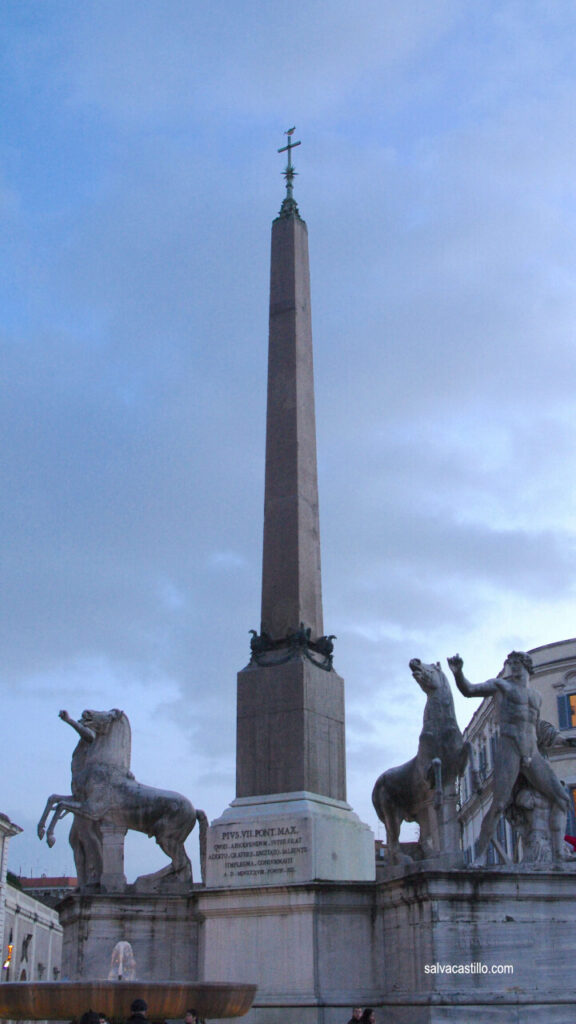
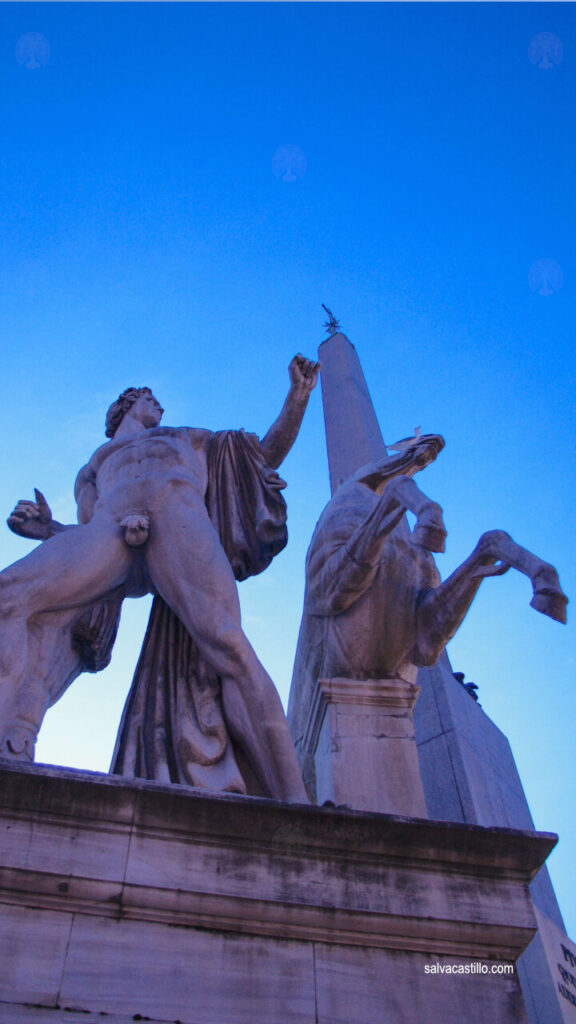
The Trajan’ Markets were built during the reign of Emperor Trajan (98-117 AD) on a hillside of Monte Quirinal. It was a multifunctional complex, composed of several buildings that housed stores, offices and other commercial spaces. They were organized on several floors: on the upper level was a large audience hall and offices. The lower floors contained a series of stores and markets, where the Romans sold products such as foodstuffs, luxury goods, slaves, clothing, and other consumer goods.

At the top of the Hill is the Militia Tower, which was built between the thirteenth and fourteenth centuries with a seven-story structure. It was part of a fortified complex that protected the Frangipani family and their interests in the city.
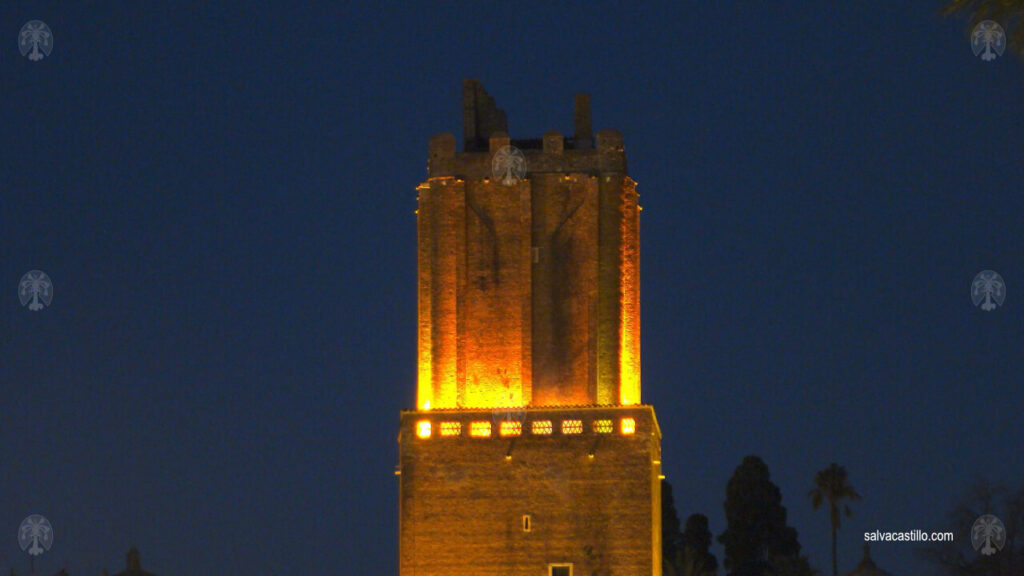
Via Dei Fori Imperiali
The polychrome marble maps on the perimeter wall of the Basilica of Maxentius showing the expansion of the Roman Empire were created by the architect Antonio Muñoz who held the position of director of the Department of Antiquities and Fine Arts.

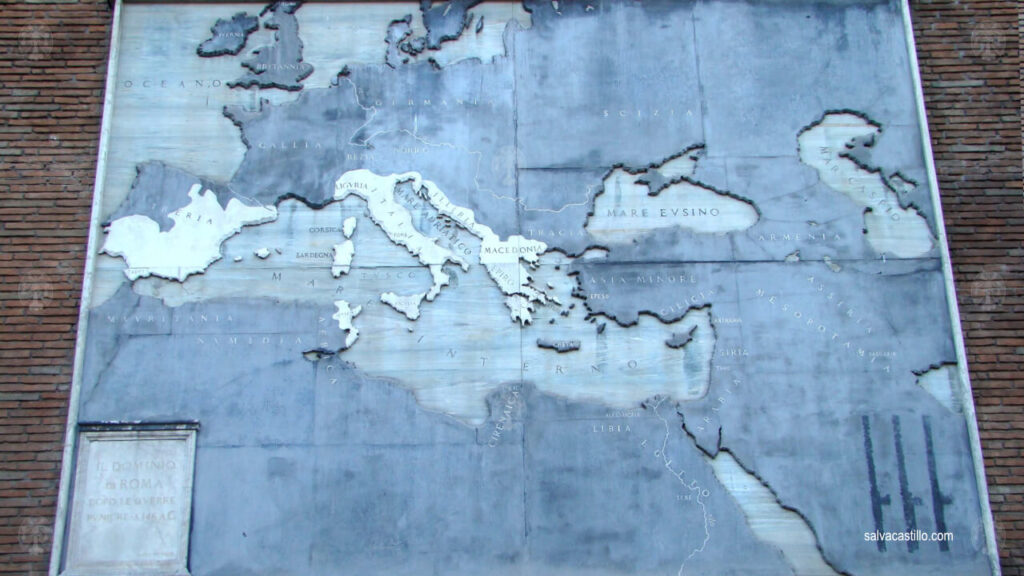
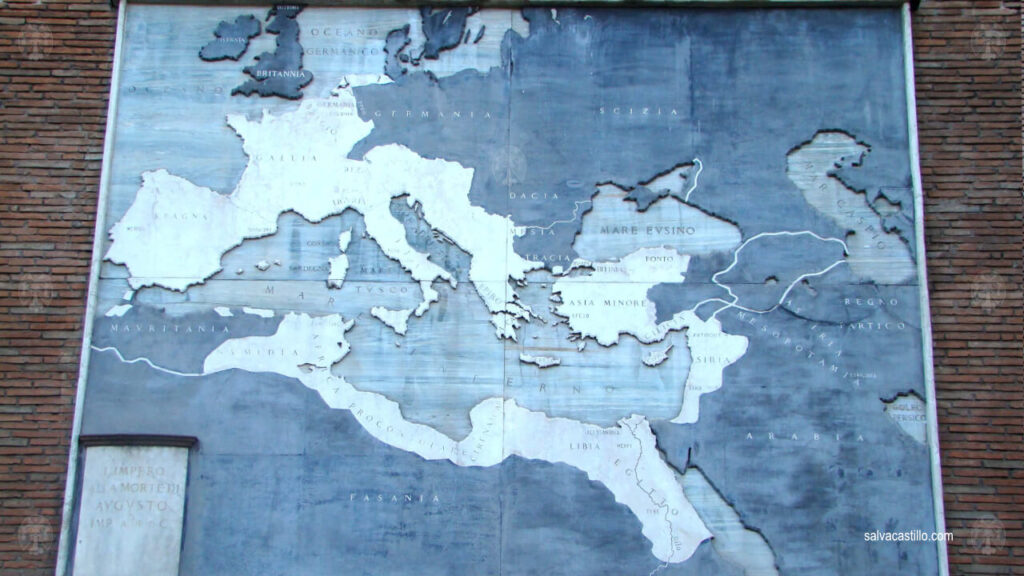

Flavian Amphitheater – The Colosseum
The Flavian Amphitheater, better known as the Colosseum, was built during the reign of the emperors of the Flavian dynasty (hence its name).
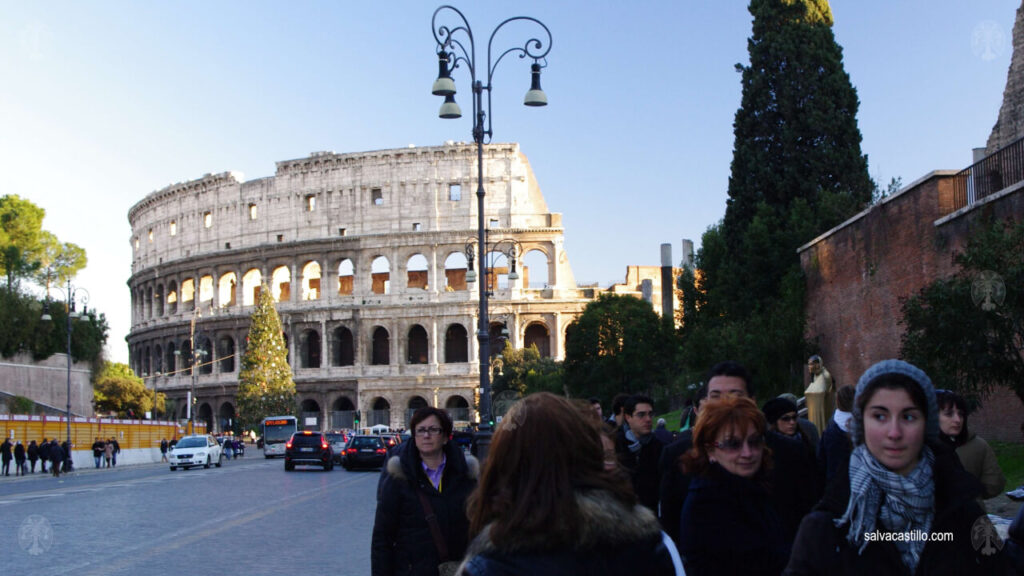
The Colosseum is one of the greatest achievements of Roman engineering.

The construction of the Colosseum began in 70 A.D., under the rule of Emperor Vespasian, the first emperor of the Flavian dynasty.

The emperor decided to erect this monumental amphitheater in the heart of Rome, taking advantage of the land occupied by Nero’s palace, which had been one of the grandest structures of imperial Rome and which after Nero’s death was confiscated.

The purpose of building the Colosseum was both public entertainment and a way to legitimize the power of the Flavian dynasty.

The official inauguration of the Colosseum took place in 80 A.D. under Emperor Titus, son of Vespasian, who held great games to mark the opening of the amphitheater.


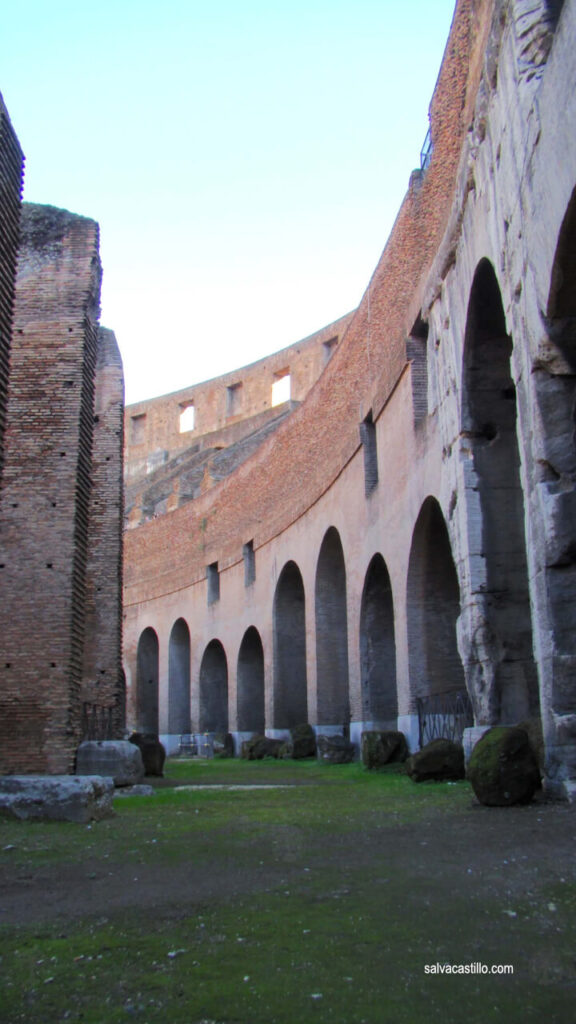
The Colosseum has impressive dimensions: it is approximately 188 meters long, 156 meters wide and has a height of 48 meters.



Its estimated capacity was between 50,000 and 80,000 spectators, although estimates vary. This makes it the largest amphitheater ever built.

The Colosseum had several entrances (about 80) that allowed for a smooth circulation of the thousands of people attending the events. Spectators were classified according to their social status, with those of higher rank seated closer to the arena and spectators of lower status located on the upper levels.
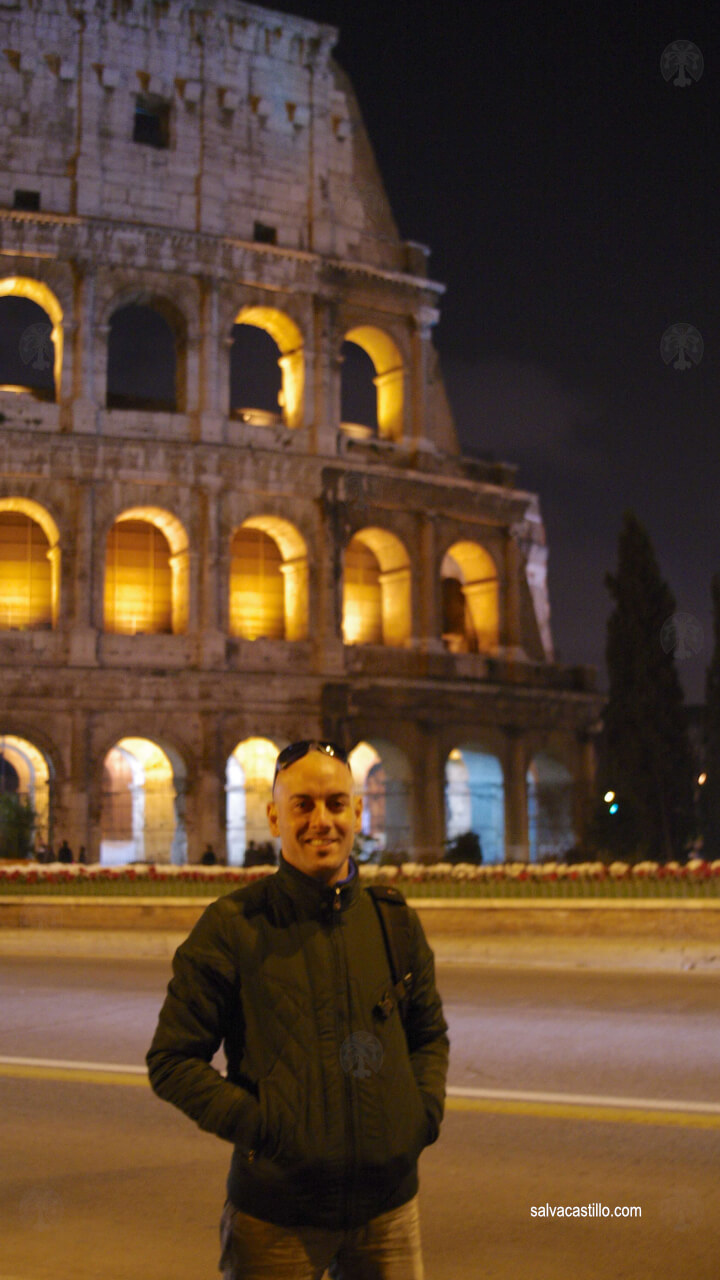
In addition to gladiatorial combats, the Colosseum was also the scene of:
Imperial festivals and celebrations, where military victories and other glorious events were represented.
Animal fights, in which wild animals brought from all parts of the empire were fought.
Naumachias (simulated naval battles), when the Colosseum was flooded to represent sea battles.
Public executions of prisoners or criminals.
Historical recreations and mythological dramas, which were often used as political propaganda tools.

An impressive place that is hard to describe. You have to go and see it, and let your imagination fly while you are there.
🛡️ ÉISAREN’T YOU ENTERTAINED YET? 🗡️